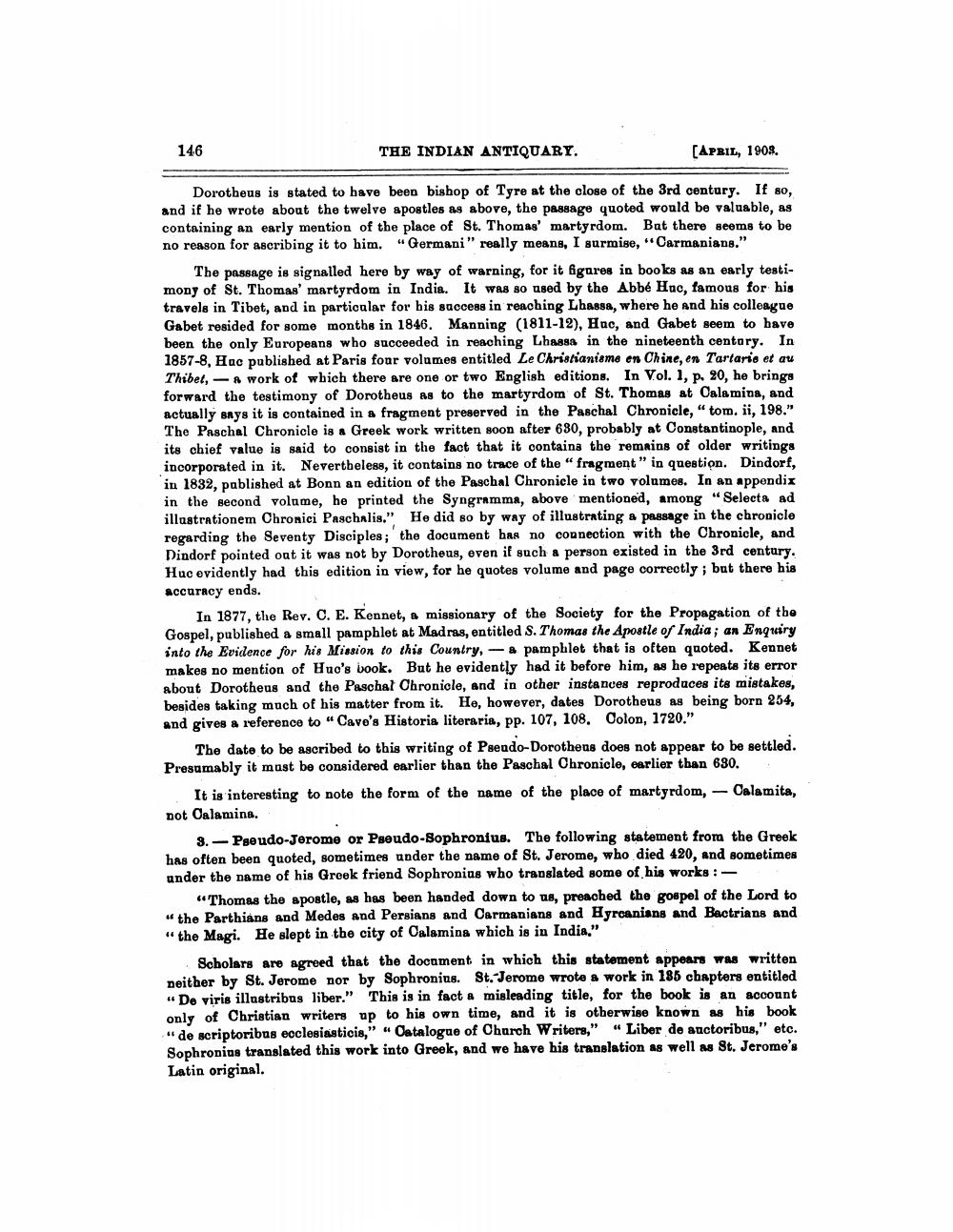________________
146
THE INDIAN ANTIQUARY.
[APRIL, 1908.
Dorotheus is stated to have been bishop of Tyre at the close of the 3rd century. If so, and if he wrote about the twelve apostles as above, the passage quoted would be valuable, as containing an early mention of the place of St. Thomas' martyrdom. Bat there seems to be no reason for ascribing it to him." Germani" really meang, I surmise, "Carmanians."
The passage is signalled here by way of warning, for it figures in books as an early testimony of St. Thomas' martyrdom in India. It was so used by the Abbé Hac, famous for his travels in Tibet, and in particular for his success in reaching Lhassa, where he and his colleague Gabet resided for some months in 1846. Manning (1811-12), Hac, and Gabet seem to have been the only Europeans who succeeded in reaching Lhassa in the nineteenth centory. In 1857-8, Huc published at Paris foar volumes entitled Le Christianisme en Chine, en Tartario et au Thibet, - A work of which there are one or two English editions. In Vol. 1, p. 20, he brings forward the testimony of Dorotheus as to the martyrdom of St. Thomas at Calamina, and actually says it is contained in a fragment preserved in the Paschal Chronicle, "tom. ii, 198." The Paschal Chronicle is a Greek work written soon after 680, probably at Constantinople, and its chief value is said to consist in the fact that it contains the remains of older writings incorporated in it. Nevertheless, it contains no trace of the "fragment" in question. Dindorf, in 1832, pablished at Bonn an edition of the Paschal Chronicle in two volumes. In an appendix in the second volume, he printed the Syngramma, above mentioned, among “Selecta ad illustrationem Chronici Paschalis." He did so by way of illustrating a passage in the chronicle regarding the Seventy Disciples; the document has no connection with the Chronicle, and Dindorf pointed out it was not by Dorotheus, even if such a person existed in the 3rd century. Huc evidently had this edition in view, for he quotes volume and page correctly; but there his accuracy ends.
In 1877, the Rev. C. E. Kennet, a missionary of the Society for the Propagation of the Gospel, published a small pamphlet at Madras, entitled S. Thomas the Apostle of India; an Enquiry into the Evidence for his Mission to this Country, - a pamphlet that is often quoted. Kennet makes no mention of Huo's book. But he evidently had it before him, as he repeats its error about Dorotheus and the Paschal Chronicle, and in other instances reproduces its mistakes, besides taking much of his matter from it. He, however, dates Dorotheus as being born 254, and gives a reference to " Cave's Historia literaria, pp. 107, 108. Colon, 1720."
The date to be ascribed to this writing of Pseudo-Dorotheus does not appear to be settled. Presumably it must be considered earlier than the Paschal Chronicle, earlier than 630.
It is interesting to note the form of the name of the place of martyrdom, - Calamita, not Oalamina.
3.- Pseudo-Jerome or Pseudo-Sophronius. The following statement from the Greek has often been quoted, sometimes under the name of St. Jerome, who died 420, and sometimes under the name of his Greek friend Sophronius who translated some of his works :
"Thomas the Sportle, as has been handed down to us, preached the gospel of the Lord to the Parthians and Medes and Persians and Carmanians and Hyrcanians and Bactrians and "the Magi. He slept in the city of Calamins which is in India."
Scholars are agreed that the document in which this statement appears was written neither by St. Jerome nor by Sophronius. St. Jerome wrote a work in 185 chapters entitled "Do viris illustribus liber." This is in fact a misleading title, for the book is an account only of Christian writers up to his own time, and it is otherwise known as his book "de scriptoribus ecclesiasticis," "Catalogue of Church Writers," "Liber de anctoribus," etc. Sophronius translated this work into Greek, and we have his translation as well as St. Jerome's Latin original.




